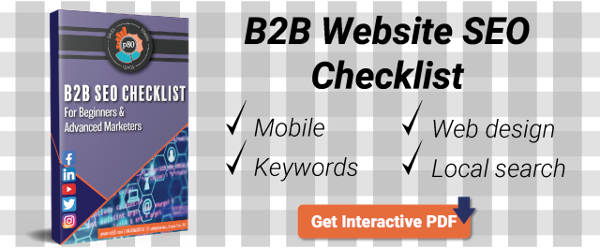Inbound Marketing Blog
for Manufacturers and Healthcare Companies
SEO Content Strategy: Your Old Content Can Still Attract Traffic
“Inbound marketing is the bee's knees! Unlike many other marketing strategies, inbound focuses on everything from getting noticed through delighting current customers. As you could guess, there are many moving parts to any successful inbound marketing strategy...some easy, minimal tasks, some time consuming, difficult tasks."
"So what's the hardest part of an inbound marketing strategy?
While this is my opinion, I will say that it's an easy answer: content.”
 This post (the one you’re currently reading) was first published on July 8, 2015. The quote above is how it originally began.
This post (the one you’re currently reading) was first published on July 8, 2015. The quote above is how it originally began.
It barely received views in the seven years before this rewrite. Every once and again, someone found it, shook off the dust, and glanced at it before setting it back in Internet obscurity. Months would go by without any new views.
This post didn’t bring us any new leads. Its high bounce rate indicated the article wasn’t enticing people to continue exploring our website. Suffice it to say this article did not help our marketing efforts.
Looking back, it’s tough to see what the SEO content strategy was. One thing is for sure: leaving this article alone doomed it to fail.
We see this all the time with new clients. Someone told them years ago they needed a blog to be competitive. They never could produce regular content, let alone refresh old content. And they don’t know how to use SEO to help their blog do its job.
That’s where an experienced B2B inbound marketing agency comes in. We can take your organization’s old content, give it new life, and create an SEO content strategy that turns your website into a lead generator.
Attracting, Engaging, and Delighting Customers With Your Blog
Inbound marketing tactics attract, engage, and delight customers through content, meaning your website is less a tool to show how awesome your company is and more a way to help prospects find solutions to their problems.
Your blog helps you engage with potential customers who seek to ease their pain points. They want to know what problems you solve, how you do it, and what value you bring them. They don’t want to see pictures of your company’s annual picnic from 2017 or your office newsletter.
They came to your site for answers. They’ll bounce to a competitor’s site if you don’t provide them quickly.
But how do people find your website in the first place?
Likely, they go to Google and type something like, “[insert problem here] in Pennsylvania.” They explore the first page of search results and often find what they need. If your website doesn’t show up on that first page, it’s likely your missing out on potential customers.
Enter the magic of SEO. With some tweaking, your existing content can be plucked from obscurity (like search result 1,235,621) and placed onto the coveted page one!
SEO Content Strategy?! Isn’t SEO Dead?
No.
Industry leaders said SEO was dead when we started in 2002, several times before this post’s original publish date, and several times since. Experts have posted online obituaries for SEO since 1997.
However, those industry doomsday prophets have been proven wrong.
The rest of us have paid close attention to SEO trends and continued to adapt so that we can provide our clients with a great ROI. As far as we’re concerned, SEO is here to stay. Providing our clients with a quality SEO content strategy allows us to produce content that attracts traffic, turns traffic into leads, and converts leads into sales.
How do we take an old, underutilized, and underperforming blog and make it generate leads? Let’s talk strategy.
Dusting Off Your Blog: Old Content Development
When we take on a new client, we spend a lot of time researching:
- We look at your customers and their needs
- We explore your competitors’ content to see how they are trying to reach the same audience
- We study industry trends that can inspire content
- We research keywords that they use in search engines to find solutions and find ways to leverage them on your website
This research allows us to tailor your content to the right audience. We work with you to create a content strategy that engages prospects and leads them through the buyer’s journey.
(Resource: Want to learn more about the buyer's journey? Download our free guide!)
We also find ways to breathe new life into your old content by:
- Analyzing it with SEO tools
- Making tweaks for quick wins
- Strengthening underperforming content
- Linking related content
- Adding appropriate calls to action
- Sharing reoptimized content on social media
Analyzing Content With SEO Tools
Plenty of software can analyze your content and tell you how it's performing. We like Semrush because of its comprehensiveness. This all-in-one tool helps us optimize content, measure traffic, and analyze competitors.
When looking at old content, we’re interested in what keywords a blog post is already ranking for, what kind of traffic the article gets, and ways to improve our SEO content strategy.
Using the On Page SEO Checker tool, we can see if a keyword is strategically used, get ideas for creating content that is SEO friendly, and see if any technical issues hinder a post.
Making Tweaks for Quick Wins
You may already have blog posts that perform well for important keywords. This post won’t need an overhaul, but a few quick tweaks could mean the difference between landing on page 2 and page 1 or ranking from number 10 to number 1.
In this case, we’ll make small changes that result in quick wins. We’ll ensure:
- Keywords are used strategically (in H1, META description, alt text, headings, and body copy)
- The post is correctly structured (It has only one H1, and the body copy is broken up using the appropriate headings)
- The text is easy to read (small paragraphs, bolded words, bullet-point lists)
- Information is up to date (those old stats from 2014 probably aren’t relevant today)
- Updating the published date to when the content was revised (Google, like humans, prefers new content)
For example, your primary keyword is found in your H1 but is missing from your META description. We’d rewrite the meta description to include the keyword. This description helps search engines and potential leads to understand what your post is about. A clear meta description focused on your keyword will help you rank better in search engines.
Strengthening Underperforming Content
Beefing up underperforming content requires significant effort. Not only will we do the tasks mentioned in the previous section, but we will analyze the content, asking:
- Is this information still relevant? If not, do we discard it, or can we overhaul it? If so, can we increase the length of the post? Is there new information we can add? Can we combine two related underperforming blog posts into one?
- Is the keyword still relevant? Keyword rankings are constantly changing. A keyword that scored high traffic and a low ranking difficulty two years ago may bring no traffic at all today. If this is the case, we will find a better keyword that brings new traffic to your site.
- Is the article too short? Putting 300 words into a post is not nearly enough for SEO. Even writing 1,000 words is not enough for Google, although we’ve found some success with content around this length. Google likes longer content, with some high-ranking posts hitting nearly 2,500 words. It may be time to add more content or combine underperforming content.
- Are competitors outranking you for the same information? Competitor analysis helps us see what type of content resonates with potential customers. If competitors produce quality content, we’ll look for ways to create even better content.
Linking Related Content
Inbound links are great for boosting SEO. If you’re producing content regularly, you probably have new content related to previous content. We look for opportunities to link content throughout your website. That blog post mentioning that popular product you make? We link the product page and any other relevant content. And, we go to the product page and link back to that blog post. Internal links help search engines better understand a site’s internal structure and determine which pages are most important to a website. However, too many internal links on a page can dilute the value of these links.
We also add related external links to blog posts. Linking to other pages, particularly those with high authority, boosts your site’s credibility.
We also ensure that links open on a new tab instead of the one your post is on to keep readers from leaving our site.
Adding Appropriate Calls to Action
Is there a call to action to which we can direct readers? These won't require you to write a lot, but technically they are content and need to be created. These will drive people from your website pages and blog posts to your landing pages containing premium content. This content helps drive lead generation and includes:
- Ebooks
- Whitepapers
- Guides
- Videos
- Webinars
We will also review your premium content and make any needed updates. We also ensure your landing and thank-you pages are updated and attractive. Potential leads can find landing pages organically, so it’s wise to have some quality content on them. We recommend having at least 350 words on a landing page. Thank you pages are usually not indexed but should still give visitors a sense they are appreciated.
Sharing on Social Media
You already have an audience on social media. Why not reshare newly revised content? Doing so gives you an initial boost in traffic. While this doesn’t directly impact your SEO, it does help improve your online visibility and organic traffic and increases brand recognition.
SEO Content Strategy is Always Changing
Reoptimizing your content is not a one-and-done thing. You may find your blog post is driving a lot of traffic and ranks on page one for relevant keywords today. However, that may not be the case a year from now. You should regularly review old content to ensure it continues to drive traffic.
However, there is no reason to be obsessive about it. We don’t usually reoptimize content that is less than six months old. Any less than that doesn’t usually provide a good ROI.
(Resource: Want to stay on top of your SEO? Download our free checklist!)
Want to Breathe New Life Into Your SEO Content Strategy?
It’s time consuming to keep content optimized, especially if you have a large backlog that you haven’t touched in years.
Optimizing old content has long been part of our SEO content strategy. We’re happy to bring your old content back to life and get it producing results for your business. Call us today:
Our Blogs, Direct to Your Inbox!
How to Audit your Online Marketing
If you are executing digital marketing, congratulations! You are most likely already one step ahead of your competition, and making strides to meaningfully connect with prospects online. But, how do you know if you’re seeing continual success year over year, and improving your metrics?
Without the tools in place to analyze and benchmark your efforts, it is impossible to scale your online marketing and ensure continuous success.




